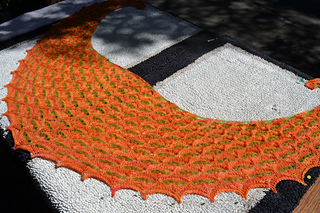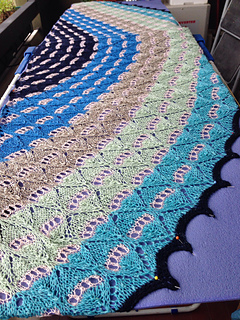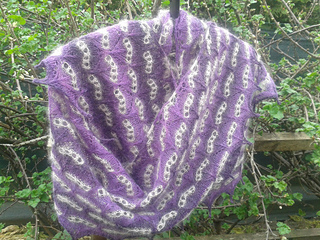patterns >  Paolo Dalle Piane's Ravelry Store
Paolo Dalle Piane's Ravelry Store
> Birdland isle






















Birdland isle
GRATIS con questo pattern: la dispensa extra CREA IL TUO GRADIENT.
Per darti l’opportunità di creare il “tuo” gradient, come alternativa ai filati sfumati già esistenti in commercio, con le indicazioni e il materiale per scegliere e combinare al meglio 3 colori solidi di tua preferenza.
Per realizzare questo modello, oltre al filato e ai ferri indicati occorrono:
- alcuni marcapunti a lucchetto
- forbici
- ago da lana
Birdland Isle è stato ispirato dalla splendida lana, tinta e filata a mano da Elbert Espeleta (alias Ravelry: Flipbrat), e dal nome stesso che lui ha dato a questo gradient.
Col suo imitare i variopinti piumaggi di alcuni uccelli tropicali, Birdland mi ha trasportato in paesi lontani. Un viaggio di fantasia percorrendo interamente la scala cromatica.
Io ho enfatizzato questi colori meravigliosi con un filato in tinta unita , molto più sottile del gradient, perché fosse solo un accento e li lasciasse emergere in tutta la loro vividezza.
Se vuoi acquistare i filati di Elbert, li trovi nel suo negozio Etsy “Chiaroscuro” (https://www.etsy.com/shop/chiaroscurodyelab).
> Note sul modello:
E’ uno scialle a mezzaluna, lavorato top-down partendo dal centro dietro interno verso il bordo esterno.
Fatta eccezione per il “garter tab cast-on” e la chiusura con picot, non richiede la conoscenza di tecniche particolari.
Ha uno schema breve e facilmente memorizzabile e sono sufficienti due marcapunti per segnare l’inizio e la fine di tutte le ripetizioni.
Le spiegazioni sono per uno scialle di 120 cm larghezza (da punta a punta) x 40 cm altezza (al centro, nel punto più alto).
Puoi però modificarlo facilmente aumentando o diminuendo il numero delle ripetizioni, ottenendo così uno scialle più grande o più piccolo sia in altezza che in larghezza.
Perché il disegno renda appieno ti consiglio di usare due colori contrastanti: un gradient per il filato più grosso (360m/100gr) e uno unito per quello più sottile (840m/100gr) e comunque di due pesi estremamente diversi l’uno dall’altro.
Dei ferri con la punta piuttosto aguzza ti saranno utili sopratutto per lavorare le parti in filato più sottile.
Grazie di cuore alle tester coraggiose che hanno corretto tutti gli errori e reso la spiegazione più chiara e snella: Anna Chiara Bellini, Adriana Monoscalco
______________________________________
FREE with this pattern: the special booklet MAKE YOUR OWN GRADIENT.
To give you the opportunity to create “your own” gradient yarn, as an alternative to the gradient yarns existing commercially, with the directions to choose and combine 3 solid colors of your preference.
To knit this pattern, in addition to yarn and needles indicated, you need:
- 2 locking stitch-markers
- cissors
- darning needle
A special thank to Donatella Mestriner (Ravelry aka iamdonatella) for correcting the english version!
Birdland Isle was inspired by the beautiful wool, dyed and hand spun by Elbert Espeleta (Ravelry aka Flipbrat), and by the name he gave to this gradient.
With its colors that imitates some tropical birds plumage, Birdland transported me in distant countries.
A fantasy journey along the entire chromatic scale.
I have emphasized these wonderful colors with a solid color yarn, much thinner than gradient one, just like an accent to pop them out in all their vividness.
If you want to buy Elbert’s hand dyed yarns, check his Etsy shop “Chiaroscuro” (https://www.etsy.com/shop/chiaroscurodyelab).
> Pattern notes:
It’s a crescent shawl, worked top-down, starting from the center of the back of the neck to the outside edge.
No knowledge of special-techniques are required, except for the garter tab cast-on and the picot bind-off.
The pattern repeat is short and easy to remember, two stitch-markers will be enough to estabilish the beginning and the end of the repeats.
120 cm (47-1/4”) width (from tip to tip) x 40 cm (15-3/4”) height (at center, at the highest point).
You can change the size easily by increasing or decreasing the number of repetitions, thus obtaining a shawl larger or smaller in both height and width.
To achieve the best result you should use two contrasting colors: a gradient for the thicker yarn (360m/100g) and a solid color for the thinner one (840m/100g) and, in any case, at least use two very different thickness.
Needles with a sharp point will be useful especially for working parts with thinner yarn.
________________________________________
Un grand merci à Christine de Savoie (Christine73 sur Ravelry) pour la traduction et l’adaptation en français.
Birdland Isle a été inspiré par la laine magnifique filée main et peinte à la main de Elbert Espeleta (Flipbrat sur Ravelry), et par le nom qu’il a donné à ce dégradé.
Avec ses couleurs imitant le plumage de certains oiseaux tropicaux, Birdland m’a transporté dans ces pays lointains. Un voyage fantastique au travers de toute la gamme chromatique.
J’ai accentué ces superbes couleurs par un fil uni, beaucoup plus fin que le fil dégradé, juste en petite touche pour les faire surgir dans tout leur éclat.
Si vous souhaitez acheter les laines peintes à la main d’Elbert, allez voir sa boutique Etsy “Chiaroscuro” (https://www.etsy.com/shop/chiaroscurodyelab).
Pour créer ce modèle, en plus de fil et aiguille nécessité indiqué, on utilise:
- anneaux-marquage de mailles (à accrocher)
- Ciseaux
- Aiguille à laine
> Pattern notes:
Ce châle en forme de croissant est tricoté de haut en bas et commence par le milieu du cou en allant vers la bordure.
A part la bandelette pour le montage et le picot pour la fermeture des mailles, ce modèle ne requiert pas de connaissances techniques spéciales pour sa réalisation.
Comme le motif à répéter est court et facile à mémoriser, deux marqueurs pour le début et la fin des répétitions sont suffisants.
120 cm de large (entre les deux extrêmités) x 40 cm de haut (au centre, à la partie la plus large).
Vous pouvez modifier les dimensions facilement en augmentant ou en diminuant le nombre de répétitions, de façon à obtenir un châle plus grand ou plus petit à la fois en largeur et en hauteur.
Pour obtenir l’ensemble du dessin, vous devez utiliser deux couleurs contrastantes : une en dégradé pour le fil le plus gros (360 m/100 g) et une autre, unie, pour le fil le plus fin (840 m/100 g), en tout cas, avec deux grosseurs différentes.
Des aiguilles à bout pointu seront utiles surtout quand vous tricoterez avec le fil le plus fin.
______________________________________
Ein grosses Dankeschön an Naphro für die schnelle und freundliche Übersetzung.
Birdland Isle entstand inspiriert durch die wunderschöne handgefärbte und –gesponnene Wolle von Elbert Espeleta (auch bekannt als Flipbrat), und dem Namen, dem er diesem Farbverlauf gegeben hat.
Mit seinen Farben, die das Gefieder tropischer Vögel imitiert, hat Birdland mich in ferne Länder transportiert. Eine Fantasiereise durch die komplette Farbpalette.
Ich habe diese wundervollen Farben mit einem einfarbigen Garn, welches viel dünner als das Farbverlaufsgarn ist, betont, damit die Farben noch besser in ihrer Lebendigkeit herauskommen.
Birdland Isle ist ein halbrundes Tuch, von oben nach unten gearbeitet, man beginnt in der Mitte des Nackens und endet an den außenliegenden Ecken.
Der Mustersatz ist kurz und einprägsam, zwei Maschenmarkierer sind ausreichend, um den Beginn und das Ende der gesamten Mustersätze zu markieren.
Es ist 120 cm Länge (von Spitze zu Spitze) x 40cm Höhe (in der Mitte, am höchsten Punkt).
Man kann die Größe leicht beeinflussen, indem man mehr oder weniger Wiederholungen strickt. Somit bekommt man in der Höhe und Weite ein größeres bzw. kleineres Tuch.
Es sind keine speziellen Kenntnisse erforderlich, außer dem “garter tab cast-on” und dem “picot bind-off”.
Um das beste Ergebnis zu erreichen, sollte man zwei gegensätzliche Farben verwenden (um einen Kontrast zu erzielen): ein dickeres Garn mit Farbverlauf (360m / 100g) und ein einfarbiges, dünneres Garn (840m / 100g). Man sollte auf jeden Fall zwei sehr unterschiedliche Garn-Stärken verwenden.
Besonders für das Arbeiten mit dem dünneren Garn sind spitze Nadelenden empfehlenswert.
57876 projects
stashed
47978 times
4222 projects
stashed
4190 times
50974 projects
stashed
36497 times
30790 projects
stashed
23354 times
41562 projects
stashed
42806 times
7507 projects
stashed
5488 times
2942 projects
stashed
2302 times
2233 projects
stashed
1929 times
26508 projects
stashed
24660 times
20 projects
stashed
4 times
48 projects
stashed
43 times
28616 projects
stashed
27582 times
- First published: February 2015
- Page created: January 24, 2015
- Last updated: April 4, 2016 …
- visits in the last 24 hours
- visitors right now




